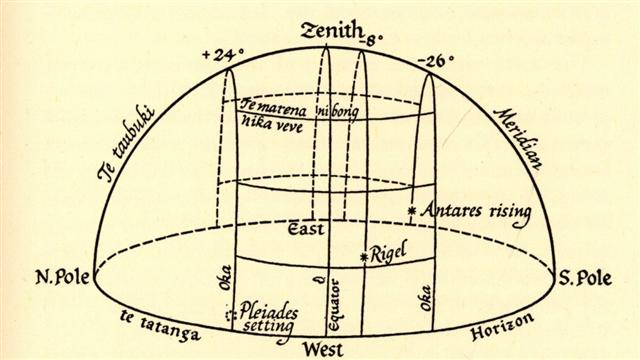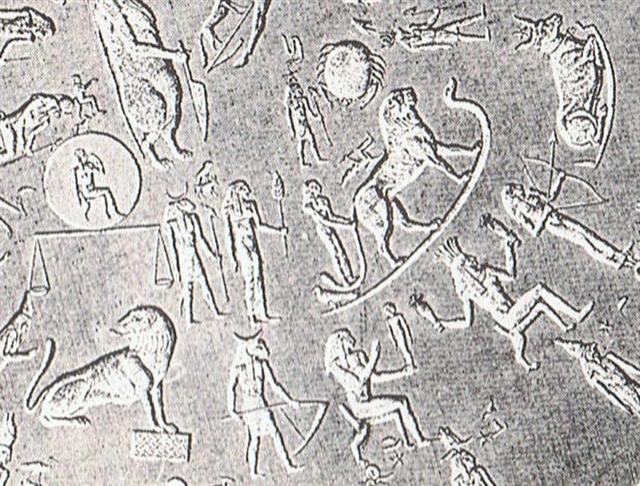6. Ana-roto is the brightest star in Virgo and earlier it was noted (cfr at Kara Etahi) that Spica was not following my imagined pattern of gradually increasing declinations towards the south:
 If such things do matter, then the only 7 minutes remaining of the '10th station' could imply the imminent end of Sun. The 10th kuhane station (counting only those on the mainland) is Hatinga Te Kohe, and then comes ('one more') Roto Iri Are, followed by Tama as number 12. 7, 11 and 53 are numbers which we recently have found to be possibly involved in measuring winter by the stars south of the equator:
Let us now insert Ana-roto in 'the center' and count distances in rectascension minutes:
I have here corrected the somewhat imprecise measures 02h 10' and 01h 50' in the earlier table to instead be 02h 11' respectively 01h 51', and allotted 1' for Sirius respectively Toliman - leaving Spica with 0'. The important role of Ana-roto is evident. She arrives after having counted the minutes to 399 (equal to the synodic cycle of Jupiter counted as days) beyond Reitanga (Sirius). A cycle of 400 will begin anew with the virgin star. 471 is the number of glyphs on the G tablet (one less than 8 * 59 but equal to 1½ * 314). Possibly, therefore, Ana-roto is at glyph number 400 (suitably a day of Venus) in the G text:
In Gb7-2 we can imagine an allusion to the 72 minutes between Spica and Toliman. Strangely Allen (in his Star Names. Their Lore and Meaning.) does not mention the name Toliman. But he says that the star once rose at autumn equinox north of the equator: "Alpha's splendor naturally made it an object of worship on the Nile, and its first visible emergence from the sun's rays, in the morning at the autumnal equinox, has been connected by Lockyer with the orientation of at least nine temples in northern Egypt from 3700 B.C. onward. As such [an] object of worship it seems to have been known as Serk-t." However, the Scorpion Goddess (Serket) is the constellation which Sun 'inhabits' at the time when Centaurus is first seen rising above the position of Sun:
In the Babylonian zodiac the figure rising before Scorpio was named The Mad Dog. According to www.solaria-publications.com: Scorpion (Scorpio) In astrology the Scorpion's armoured body segments and its array of weaponry predisposed it to become a creature symbolizing war and the martial prowess of the king. However a different meaning is attached to it in mythic texts such as the Gilgamesh Epic where Scorpion-men and women guard the sacred mountain through which the hero has [to] traverse on his quest for immortality. The Scorpion-people are said to guard the sun at his rising and setting and because Gilgamesh is a favourite of the sun god they allow him to travel the subterranean path that the sun travels every night under the mountain. Mad Dog (Lupus) The Mad Dog is probably a relic of an ancient star configuration which included the now derelict Bison-man. Together they constituted a version of the 'Lion-bull' conflict, which is widely thought to symbolise the seasonal conflict between summer and autumn. Here the bull, who represents the autumn rains slays the lion of summer. The hand of the The Mad Dog is significantly joined to the straight line which presumably connects the equinoxes:
Counting from Sirus to Toliman there are 472 minutes, which we can approximate with 4 months. 472 / 60 = 7.87 hours and 7.87 / 24 * 12 = 3.93 months. However, if we count with 59 minutes per hour the result will be exactly 4 months (472 / 59 * 12 / 24 = 4). This agrees fairly well with the distance from Arrow to Mad Dog. Arrow (Sirius & probably other adjacent stars in Canis Major) Although closely associated with the constellation of the Bow, the Arrow is always treated separately in Babylonian tradition. The annual rising of the Arrow marked the summer solstice when the sun was at its maximum height above the horizon. The Arrow was probably chosen for this role as it is the man-made object that can reach highest into the heavens. Similarly, the bird on a high perch, which is often seen besides the Arrow in ancient artwork, can also be thought of as representing the sun at its highest station. Spica is related to the pair Frond and Furrow, and the distance from Spica to Toliman can be approximated as 73 / 59 * 12 / 24 = 0.6 months. Frond (Coma Berenices & western part of Virgo) The Frond is represented in the heavens by the figure of the goddess Erua holding her sacred branch of the Date-palm. Her constellation rises in the autumn months as the dates are ripening on the fronds. Furrow (Eastern half of Virgo) The Furrow is obviously the origin of our modern Virgo with her familiar ear of barley. The constellation rises in the autumn when the fields have been prepared and are ready to be sown with the coming season's barley seed. I think the pair Frond and Furrow are similar to the double pairs (like twins) in front of the Lion looking back:
There is both a 'blue' (located low in the sky) pair and a 'black' (in the normal zodiac band) pair, which probably indicates these double pairs are located earlier than at autumn equinox, at a time when Sun still is following his summer path high above. The upper ('black') figures are standing tall in contrast to the lower ('blue') figures. But the horns on the male figures could mean, I guess, that the 'bull of autumn rains' has began to make himself felt. |
|||||||||||||||||||||||||||||||||||||||||||||||||||||||||||||||||||||||||||||||||||||||||||||||||||||||||||||









